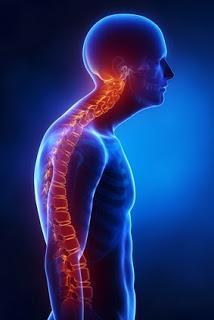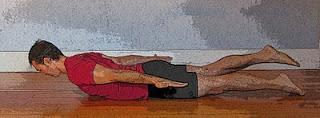A: This is an interesting question: what to do with the student who has kyphosis of the thoracic spine, the part of the spine in the area of the rib cage? What can we do as yoga practitioners to prevent the progression of the spinal changes we are seeing, and is it possible to reverse the excessive posterior curve in the upper back? And should we be more attentive to this area when we are younger and possibly avoid this kind of change in the upper back (yes!)?
 As we have discussed in the past, the normal anatomy of the spine involves a gentle, undulating set of curves from head to tail. From the backward curve of the back of the skull, as we move into the cervical (neck) spine, the spine curves forward toward the front of the body. As we travel down into the thoracic (rib cage area) spine, there can be a natural backward curve, although in indigenous peoples and from ancient sculpture there is evidence that minimal curve in this area might be a healthier variation (see the work of Esther Gohkale). As we proceed further south and enter the lumbar (lower back) spine, the spine curves toward the front of the body once again. Finally, the sacrum curves backwards to complete the serpentine trail of the spine.
As we have discussed in the past, the normal anatomy of the spine involves a gentle, undulating set of curves from head to tail. From the backward curve of the back of the skull, as we move into the cervical (neck) spine, the spine curves forward toward the front of the body. As we travel down into the thoracic (rib cage area) spine, there can be a natural backward curve, although in indigenous peoples and from ancient sculpture there is evidence that minimal curve in this area might be a healthier variation (see the work of Esther Gohkale). As we proceed further south and enter the lumbar (lower back) spine, the spine curves toward the front of the body once again. Finally, the sacrum curves backwards to complete the serpentine trail of the spine.According to the Mayo Clinic website (I love these folks!):
“Kyphosis is a forward rounding of your upper back. Some rounding is normal, but the term "kyphosis" usually refers to an exaggerated rounding — sometimes called round back or hunchback. While kyphosis can occur at any age, it's most common in older women where the deformity is known as a dowager's hump.”
Today, I am interested in kyphosis that occurs in older adults. In my experience, I have encountered this pronounced curve in both older men and women. The Mayo clinic notes that it occurs more often in women, likely due to the earlier onset of osteoporosis (OP) in women. What’s the OP connection?
The most common site of fracture in people with osteoporosis is the spine, and more specifically the thoracic spine. The typical fracture in the area is called a wedge fracture, in which the body of the vertebrae, that kidney bean-shaped biggest part becomes so thin that the front part collapses, and when seen from the side, it looks like a wedge. If you get several of the vertebrae in a row doing that, then the whole upper spine begins to bow forward like the Kokopelli image.
 In some instances this will result in stiffness and difficulty maintaining an upright posture, and for some pain will also arise. Along with pain, in more severe cases of kyphosis, the change in spinal curve can affect your lungs, nerves, and other tissues and organs. So we need to do at least one important thing before we start moving these students of our reader around a lot: have them see their family doctor for an X-ray of the thoracic spine to see if fractures have already happened and get a DEXA scan to rule out OP if this has not been done. Once you know their OP status, you can make better decisions around yoga poses and practices.
In some instances this will result in stiffness and difficulty maintaining an upright posture, and for some pain will also arise. Along with pain, in more severe cases of kyphosis, the change in spinal curve can affect your lungs, nerves, and other tissues and organs. So we need to do at least one important thing before we start moving these students of our reader around a lot: have them see their family doctor for an X-ray of the thoracic spine to see if fractures have already happened and get a DEXA scan to rule out OP if this has not been done. Once you know their OP status, you can make better decisions around yoga poses and practices. Two other important factors that can contribute to kyphosis in older adults are disc degeneration (we have written about this, too) and cancer and cancer treatments (which can weaken the vertebrae and contribute to fractures as well).
Your western doctor may recommend certain treatments:
- If there is OP present, medications to treat osteoporosis might be prescribed.
- If pain is present, pain relieving meds could be recommended.
- If the person’s condition is compressing a nerve or causing some other significant problem, surgery to fuse bones could be suggested, but the risk of complications is high and tends to minimize this option.
- Physical therapy exercises are prescribed to improve flexibility in the spine, as well as ones to strengthen the abdominal muscles to help support better posture.
If you don’t yet have a copy of Loren Fishman’s book Yoga for Osteoporosis and you are working with older adults, perhaps today’s the day to order it! It is a good resource of suggested poses and ways of doing them that you will likely find invaluable. A valuable piece of advice from the book regarding patience with these students is:
“Although yoga can be slow, requiring months or even years to achieve major effects, the trip is pleasant…”
So, with patience in mind, in regards to the reader’s observations, I’d suggest that for Downward-Facing Dog with the chair, if they are putting the hands on the seat of the chair, bring them up to the back rung, and if already on the back rung, do a higher version of Half Dog Pose at the Wall.

Half Dog Pose at the Wall
Let them bend their knees a bit and focus on lengthening their spines to whatever degree they can pain free. Even if not much seems to be happening in Cat/Cow pose, keep doing it anyway. I like the effect of dynamic movements like that for loosening tightness up gently. Along those lines, have them stand in Mountain pose with their backs to the wall, perhaps with the kyphosis lightly touching the wall. Then have them inhale one arm forward and up overhead and exhale it back down. Repeat with the other arm. Do several sets of these. The mere act of taking the arm overhead will begin the encourage extension of the upper back, exactly what you are looking for here, and strengthen the upper back muscles that assist in this goal. You could obviously do this sitting as well.If they can easily get down to the floor for Savasana, I find that no lift is needed under the thoracic spine, but a lift is definitely needed under the head so it stays level with the chest. Over-extending the neck has its own set of worries you don’t want to cause! In that reclining position, you can again have them work the arms as we did in Mountain pose.
To strengthen the abdominals, you could create a variation of Boat pose (Navasana) done sitting at the front edge of a chair, lifting one bent leg up a few inches and holding it in position for a few breaths, then lowering that foot to floor and repeating with the second leg. Again, if they can get to the floor and you can teach them Locust pose (Salabasana) or even one-legged Locust (which takes the spine into extension), you can have them do that at home or even in bed if they have a firm mattress.

One-Legged Locust Pose
I’ve already gone on a bit too long today, but I do believe that by intervening now and getting these people to practice at home as well as in class, you have a good chance of stopping the progression of the kyphosis and in some cases, where no wedge fractures have altered the anatomy, maybe even helping to reverse it! Please let us know how things go.
